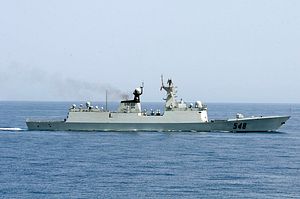Since the release of the Department of Defense’s “2020 China Military Power Report” this past September, much has been made of China’s securing the title of the “world’s largest navy.” Indeed, the United States Office of Naval Intelligence has confirmed that the People’s Liberation Army Navy (PLAN) has surpassed the United States Navy in total battle force ships, approximately 360 to 297, with future projections expecting the gap to grow. By 2025, the PLAN is predicted to field as many as 400 vessels whereas the United States plans only to field 355. Quantitative discussions of this sort have fostered an increasing level of hysteria in the U.S. media and even parts of its foreign policy and defense establishments.
What such discussions fundamentally misunderstand about the two fleets, however, are the major differences in force structure as well as the incomparable regional ally differential maintained by the United States. In fact, most discussions about the size of the PLAN inflate its surface warship fleet by including either small coastal patrol ships or its amphibious transports and landing ships.
In order of descending size, the PLAN’s surface force is comprised of two aircraft carriers, one cruiser, 32 destroyers, 49 frigates, 37 corvettes, and 86 missile-armed coastal patrol ships. In addition, China’s submarine fleet includes 46 diesel-powered attack submarines, six nuclear-powered attack submarines, and four ballistic missile submarines. This is further supplemented by the China Coast Guard, which fields roughly 255 coastal patrol ships. In sum, China has a surface warship fleet of 121 vessels, a submarine fleet of 56 platforms, and another 341 coastal patrol ships.
For its part the United States Navy boasts a surface fleet of 11 aircraft carriers, 92 cruisers and destroyers, and 59 small surface combatants and combat logistics ships. Its submarine fleet is comprised of 50 attack submarines, 14 ballistic missile submarines, and four cruise missile submarines. As such, the United States maintains a surface fleet of about 162 vessels, depending on the inclusion of its small combatants and combat logistics ships, and a submarine fleet of 68 platforms.
Here we clearly see that talk of China’s massive navy is rather out of proportion. It should be noted that China’s fleet relies disproportionately on smaller classes of ships, like the frigate and corvette, which are widely considered not to be major surface combatants. Even still, the bulk of its numbers advantage comes from its coastal patrol ships which, while not insignificant, have limited capacity to project power beyond China’s near seas. Further, the United States maintains a massive carrier advantage. Wherever one falls on the debate over the continued viability of aircraft carriers, the fact remains that both states are interested in producing them.
Even more confounding is the conspicuous failure to account for U.S. allies, which are generally referenced only as brief afterthoughts in discussions of the need for the United States to ramp up its naval forces. Ostensibly, the naval buildup is aimed at reassuring U.S. regional allies. Yet the naval forces of such allies are seldom, if ever, part of the equation. At a time when much of the U.S. national security ethos has placed emphasis on “making allies pay their fair share,” it’s a rather paradoxical initiative.
For reference, China’s single formal ally – North Korea – maintains a handful of submarines and coastal patrol vessels. In contrast, the United States has formal military alliances with six Indo-Pacific states – Australia, Japan, New Zealand, the Philippines, South Korea, and Thailand. Moreover, many regional powers – notably India, Indonesia, Singapore, Taiwan, and Vietnam – maintain ever-deepening security relationships with the United States due precisely to concerns over potential threats from China.
While the United States does remain the primary guarantor of security for states such as Japan and South Korea, they are by no means helpless. Indeed, the Japanese Maritime Self-Defense Force maintains one of the largest surface fleets in the world, containing 51 major surface combatants. Likewise, South Korea’s naval forces total 23 major warships, with eyes on major expansions. Nonetheless, the role of allied fleets goes largely unmentioned in U.S. national security discourse.
All this is not to say that the United States should neglect its naval forces. Far from it, the United States Navy is arguably the most important day-to-day component of the U.S. military on the international stage. Rather, I would encourage a greater degree of skepticism toward distinct force goals. It would likely serve U.S. interests better to shift focus towards modernizing current platforms and investing in developing new systems.
American analysts and commentators would do well to remember that the United States is not alone in its concerns about the expansion of the China’s navy. That calls for the massive enlargement of the United States Navy, notably to 500 vessels, seldom acknowledge the potential roles and contributions of allies is startling.

































